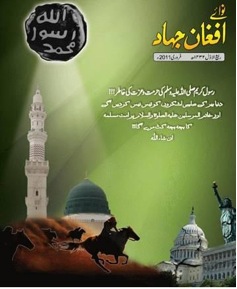
The image is the cover of the February 2011 issue of the magazine Nawa-i-Afghan Jihad. The horse and rider motif is common in jihadi visual propaganda.The rider emphasizes the element of human agency in jihad, and is a way to enhance the traditional symbol of a horse and flesh out notions of aggression and the call to jihad.
The horse–an important symbol in both pre-Islamic Arabia and Islamic culture-–has been ascribed with the positive qualities of chivalry, bravery in battle and victory, as evidenced in pre-Islamic poetry, the Qur’an, hadiths and other genres of literature. For example, the beginning of the Qur’anic sura 100 talks about “running horses” that appear as galloping through the world toward the final goal, namely, Judgment Day. Horses are also symbolic of the first generation of Muslims and that generation’s successful military campaigns, and thus are often employed to evoke specific Salafi religious sentiments with regard to the military victories of Muhammad and his companions. In this way, the horse motif places current jihadi activities within the same unfolding dialectic as the jihad of early Islam. The horse and rider here are seen riding from an area dominated by a minaret and mosque, the domed mosque is the Prophet’s mosque in the holy city of Medina, which are representative of the notion dar al-Isalm (“abode of Islam”), and toward an area dominated by symbols of American power, which represent dar al-harb (“abode of war”). Thus, the image conveys the idea of Islam’s future domination and conquest of the West.
 Skip to content
Skip to content
